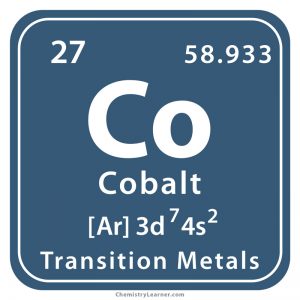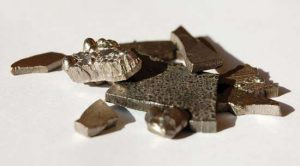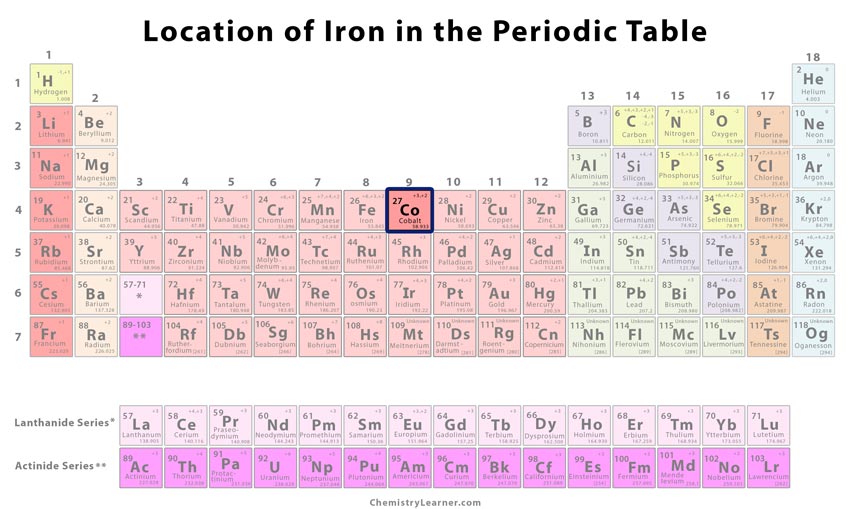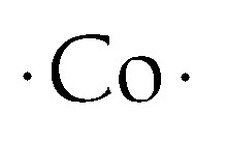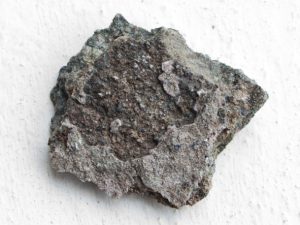Cobalt
What is Cobalt
Cobalt (pronunciation: KO-bolt) is a hard, lustrous silvery-blue element belonging to the group of transition metals, and it is represented by the chemical symbol Co [1, 2, 3]. It is chemically active and can form many compounds [4]. It is a ferromagnetic metal that can be magnetized and is alloyed with nickel and aluminum to produce powerful magnets [1, 4].
Isotopes
It has one stable, naturally occurring isotope, 59Co and 28 radioisotopes out of which the most stable are 60Co, 57Co, 56Co, and 58Co with half-lives of 5.2714 years, 271.8 days, 77.27 days, and 70.86 days respectively [5]. The half-life periods of its other radioisotopes are less than 18 hours [5].
Where is Cobalt Found
Cobalt naturally occurs in combination with other elements in the mineral ores like cobaltite (a sulfide containing cobalt, arsenic, iron, and nickel), erythrite (hydrated cobalt arsenate), and skutterudite (cobalt arsenate) [1]. It is generally obtained as a byproduct of copper and nickel mining [1, 4].
The manganese nodules found on the ocean floors are huge reserves of transition metals, containing tons of cobalt [1]. The top 3 cobalt reserve holding countries are the Democratic Republic of Congo (DRC), Australia, and Cuba while the top 3 producers include DRC, China, and Zambia [1].
History
Origin of its Name: The name is derived from ‘kobald’, German for “goblin” and from ‘cobalos’, a Greek word meaning “mine” [1, 2].
Who discovered it: The element was found by the Swedish chemist and mineralogist Georg Brandt [1].
When and How was it Discovered
The tomb of Tutankhamen, the ancient Egyptian Pharaoh who ruled during 1361-1352 BC, had a deep blue glass object that was made of cobalt [1]. In China, cobalt blue was used for making pottery glazes [1].
Aside from its ancient origins, its discovery in the recent times dates back to the 1730s when Georg Brandt was interested in a blue ore from some of the local mines [1]. Finally, he succeeded in proving that the blue ore contained a new metal [1]. He described its properties and published the results in 1739 [1, 3].
His discovery was controversial, as other chemists disputed his findings for many years [1]. However, his fellow Swedish chemist Torbern Bergman conducted further studies and confirmed Georg Brandt’s discovery in 1780 [1, 3].
Cobalt Identification |
|||
| Atomic number | 27 [1] | ||
| CAS number | 7440-48-4 [1] | ||
| Position in the periodic table | Group | Period | Block |
| 9 [1] | 4 [1] | d [1] | |
Properties and Characteristics of Cobalt
General Properties |
||||||||||||||||
| Relative atomic mass | 58.933 [1] | |||||||||||||||
| Atomic mass | 58.933 amu [1] | |||||||||||||||
| Molar mass | 58.9331950 ± 0.0000050 g/mol [6] | |||||||||||||||
| Molecular weight | 58.933 g/mol [7] | |||||||||||||||
Physical Properties |
||||||||||||||||
| Color | Silvery-blue, bluish-white [1, 4] | |||||||||||||||
| Melting point/freezing point | 1495 °C, 2723 °F [1] | |||||||||||||||
| Boiling point | 2927 °C, 5301 °F [1] | |||||||||||||||
| Density | 8.86 g cm-3 [1] | |||||||||||||||
| State of matter at room temperature (solid/liquid/gas) | Solid [1, 4] | |||||||||||||||
| Hardness | ||||||||||||||||
| – Brinell | 700 MPa [8] | |||||||||||||||
| – Mohs | 5 [8] | |||||||||||||||
| – Vickers | 1043 MPa [8] | |||||||||||||||
| Electrical Conductivity | 1.7 X 107 S/m [8] | |||||||||||||||
| Ionic Charge | 3+ [9] | |||||||||||||||
| Thermal (heat) conductivity | 100 W/(m K) [8] | |||||||||||||||
| Specific heat | 421 J kg-1 K-1 [1] | |||||||||||||||
| Bulk modulus | Unknown [1] | |||||||||||||||
| Shear modulus | Unknown [1] | |||||||||||||||
| Young’s modulus | Unknown [1] | |||||||||||||||
| Vapor pressure | ||||||||||||||||
| – Temperature (K) | 400 | 600 | 800 | 1000 | 1200 | 1400 | 1600 | 1800 | 2000 | 2200 | 2400 | |||||
| – Pressure (Pa) | – | – | – | 2.09 X 10-10 | 1.00 X 10-6 | 4.19 X 10-4 | 0.0379 | 1.15 | 16 | – | – | |||||
Chemical Properties |
||||||||||||||||
| Oxidation state/Oxidation number | -1, +1, +2, +3, +4, +5 [1] | |||||||||||||||
| Isotopes | Isotope | Mass | Abundance (%) | Half-life | Mode of decay | |||||||||||
| 59Co | 58.933 | 100 | – | – | ||||||||||||
Atomic Data of Cobalt (Element 27)
| Valence electrons | 9 [10] | |||||||
| Quantum numbers | ||||||||
| – n | 3 [11] | |||||||
| – ℓ | 2 [11] | |||||||
| – mℓ | -1 [11] | |||||||
| – ms | -1/2 [11] | |||||||
| Electron configuration (noble gas configuration) | [Ar] 3d74s2 [1] | |||||||
| Atomic structure | ||||||||
| – Number of electrons | 27 [4] | |||||||
| – Number of neutrons | 32 [4] | |||||||
| – Number of protons | 27 [4] | |||||||
| Radius of Atom | ||||||||
| – Atomic radius | 2.00 Å [1] | |||||||
| – Covalent radius | 1.18 Å [1] | |||||||
| Electronegativity (Pauling-scale) | 1.88 [1] | |||||||
| Electron affinity | 63.873 kJ mol-1 [1] | |||||||
| Ionization energy (kJ mol-1) | 1st | 2nd | 3rd | 4th | 5th | 6th | 7th | 8th |
| 760.402 | 1648.356 | 3232.3 | 4949.7 | 7670.6 | 9842 | 12437 | 15225.4 | |
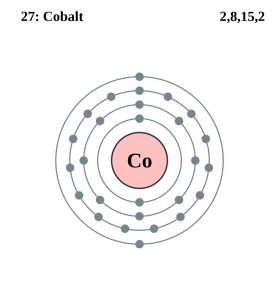
Cobalt Electron Configuration (Bohr Model)
What is Cobalt Used for
- Cobalt is alloyed for use in gas turbine generators and jet turbines because of its high-temperature strength and resistance to corrosion [1, 4].
- Cobalt is occasionally used in electroplating owing to its hardness and attractive appearance [1].
- It is commonly used as a cathode material in lithium ion batteries [4].
- Cobalt salts are used to impart intense blue colors in glass, porcelain, pottery, enamels, and paint [1].
- Radioactive 60Co is used for treating cancer, and in food irradiation for controlling pathogens and extending shelf life [1].
- Stellite super-alloys, composed of chromium, cobalt, and tungsten, are used for making high temperature and high wear resistant cutting tools [2].
Cobalt Toxicity and Health Effects
Cobalt poisoning can take place when you accidentally ingest, breathe, or have it in contact with the skin in large amounts [12]. In large quantities, cobalt can be carcinogenic in humans and some animals [1].
It is found in trace amounts in humans and is an essential component of vitamin B12 [1]. Small doses of cobalt are also given to some animals to prevent mineral deficiencies in them [1].
Interesting Facts
- Cobalt is graphically represented by a ‘kobold’ or goblin (considered troublesome by the medieval German miners) with some Chinese porcelain in the background, referring to its use as a pottery glaze in ancient China [1].
- Cobalt can retain its magnetic properties up to a temperature (Curie Point) of 1,121 °C (2049.8 °F), the highest of all the ferromagnetic elements [3, 4].
- In 2010, German scientists used a cobalt atom to capture the first pictures of spin changing [3].
Price of Cobalt
The cost of pure cobalt is about $0.21 per gram, and in bulk, it costs about $0.044 per gram [4].
- References
- http://www.rsc.org/periodic-table/element/27/cobalt
- https://education.jlab.org/itselemental/ele027.html
- https://www.livescience.com/29275-cobalt.html
- https://www.chemicool.com/elements/cobalt.html
- https://education.jlab.org/itselemental/iso027.html
- https://www.webqc.org/molecular-weight-of-Co%28cobalt%29.html
- https://pubchem.ncbi.nlm.nih.gov/compound/cobalt#section=Top
- http://periodictable.com/Elements/027/data.html
- http://www.gpb.org/files/pdfs/gpbclassroom/chemistry/ionicChargesChart.pdf
- http://dwb4.unl.edu/Chem/CHEM869B/CHEM869BLinks/learn.chem.vt.edu/tutorials/bonding/valence.html
- http://chemistry-reference.com/q_elements.asp?Symbol=Co&language=en
- https://medlineplus.gov/ency/article/002495.htm
